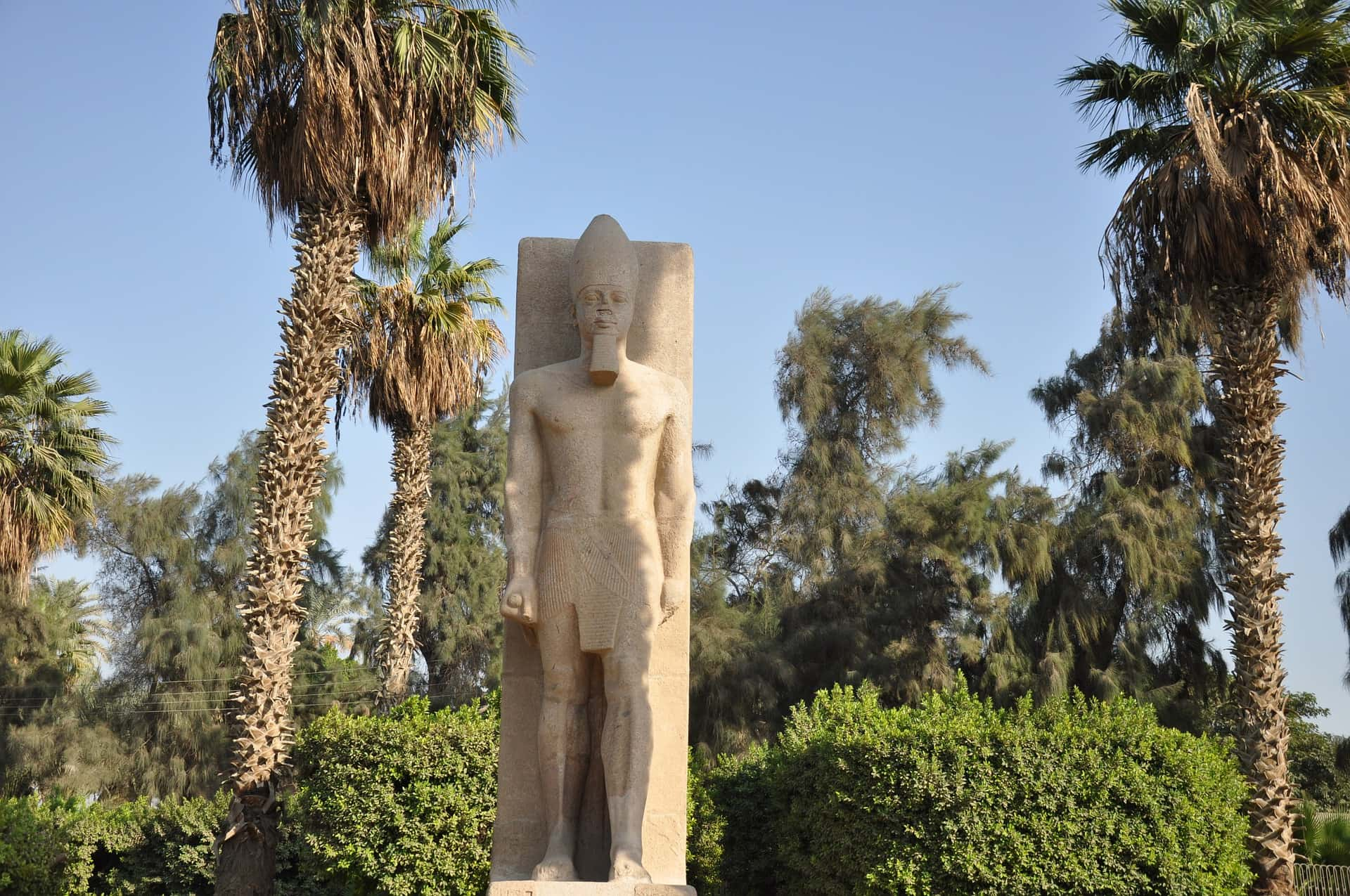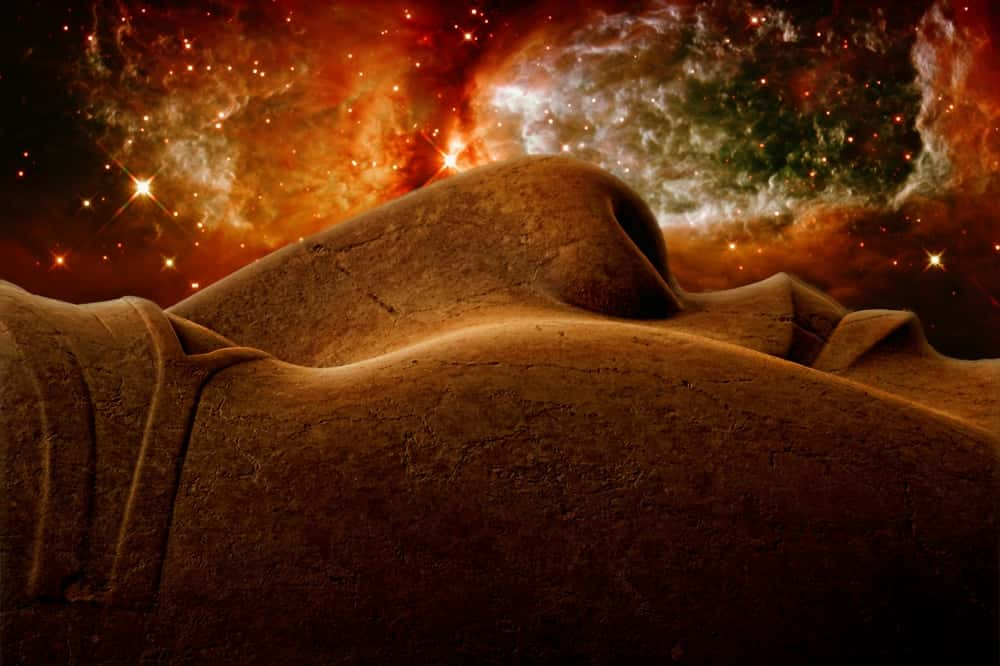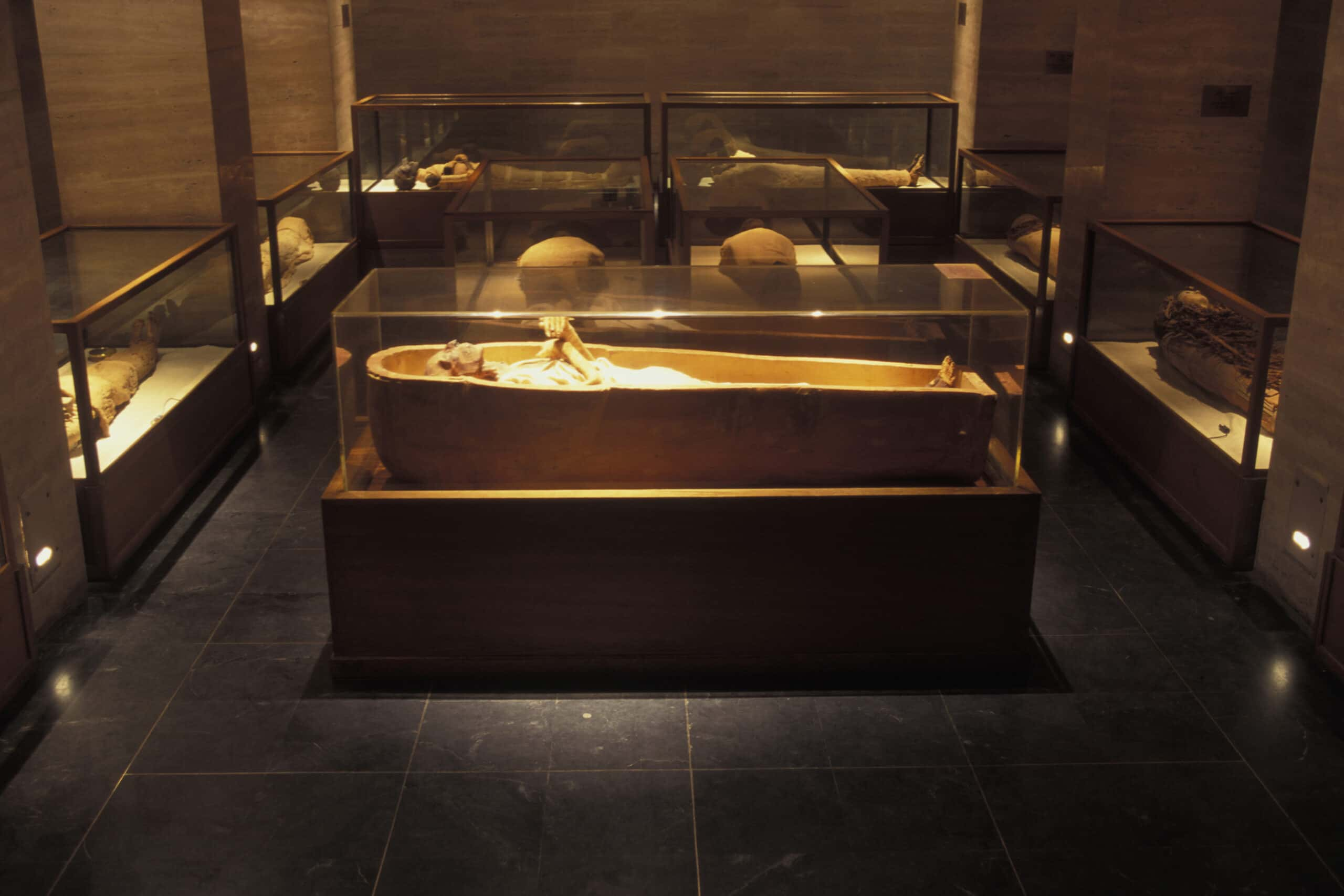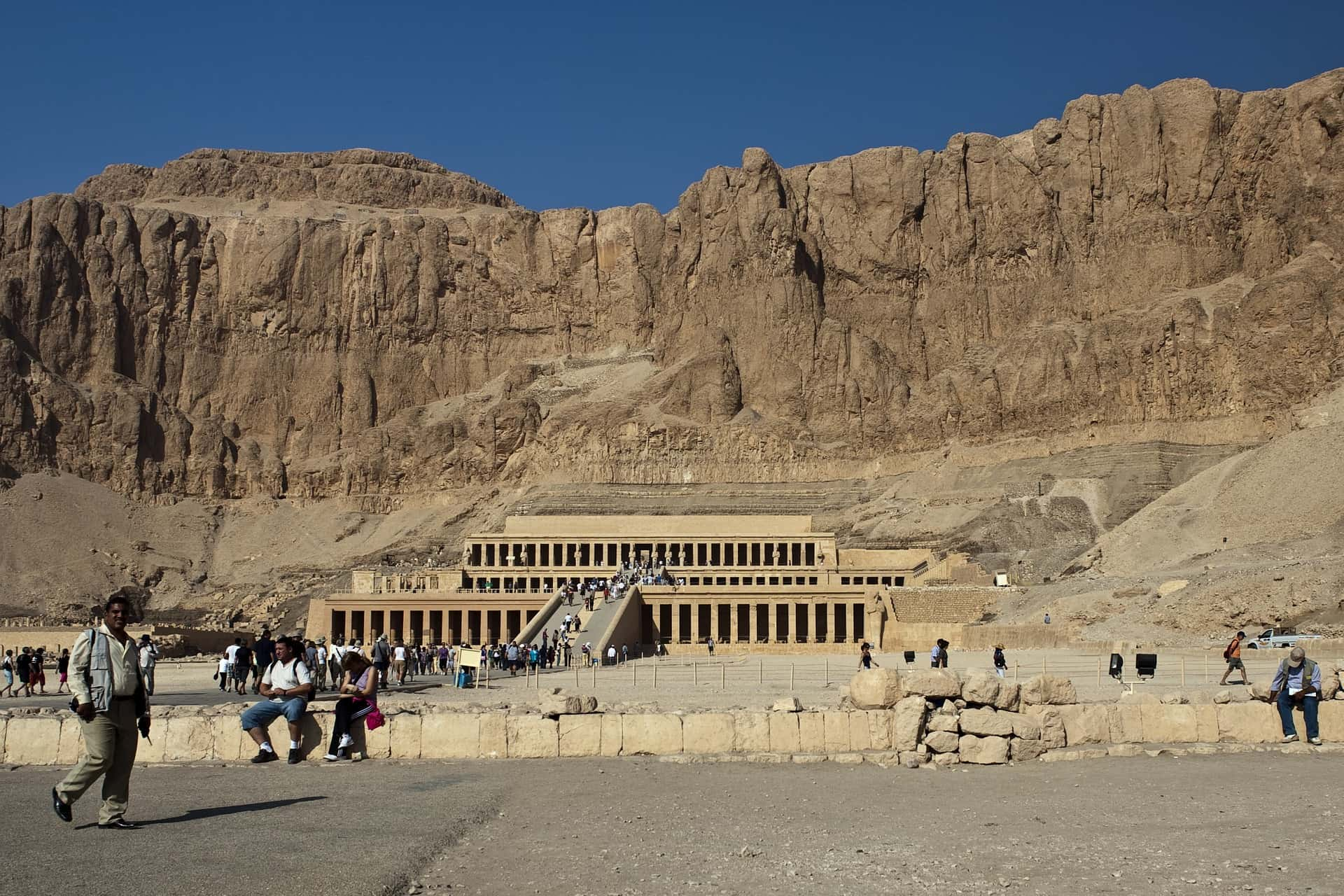The real historical Ramses the Great makes most kings seem downright gentle by comparison. This prideful pharaoh led his armies from the front lines and left countless monuments to his dramatic reign. But who was the man behind all of those imposing statues? There was a chilling darkness to this legendary figure. Dive into the mighty history of Ramses II of Egypt and find out for yourself.
1. He Lived an Extremely Long Time Ago
Ramses II lived a really, really, really long time ago. He was born in 1303 BC—that means he's over a thousand years older than Julius Caesar. He's so old that no written work about him survives. But that didn't stop Ramses the Great from leaving his mark.
2. He Spread His Seed Far and Wide
As far as pharaohs go, Ramses is about as big as they get. In the man's remarkably-long 96 years, he put his stamp on almost every corner of Egypt. He took over 200 wives, had 156 kids, and managed to outlive almost all of them. If his name sounds familiar, maybe it's because nine more pharaohs named themselves after him. So what made Ramses II so great? Where to begin...
 Exodus: Gods and Kings (2014), 20th Century Fox
Exodus: Gods and Kings (2014), 20th Century Fox
3. He Left His Mark Everywhere
One of the reasons that Ramses is so well-known is that he really wanted you to know about him. The great Ozymandias was many things, but humble he was not. He made sure that workers inscribed his name and likeness on almost any surface he could get his hands on. In fact, you basically can not find a single Ancient Egyptian ruin that doesn't have his name somewhere or another.
But while the man liked to brag, it's not like he couldn't back it up...
4. He Didn't Waste Any Time
Ramses' father, Seti I, made sure his son started early. The young prince was already joining his father on the battlefield by the time he was 14. Ramses had campaigned in Libya and Palestine before he could even get a driver's license! And that's not the only thing he got an early start at...
 Exodus: Gods and Kings (2014), 20th Century Fox
Exodus: Gods and Kings (2014), 20th Century Fox
5. He Married Early and Often
You don't end up with 200 wives without getting an early start. Ramses got married for the first time when he was just 15, and he didn't waste any time spreading his seed. He was bringing his own little tykes on campaign with him by age 22. He became pharaoh at 25, presumably while celebrating his tin anniversary with his wife—or, we should say, his first wife. By that point, he'd already married many women and had seven kids.
So, did the rigors of parenthood slow this new pharaoh down? Not exactly...
 Exodus: Gods and Kings (2014), 20th Century Fox
Exodus: Gods and Kings (2014), 20th Century Fox
6. He Was Always Ready For a Fight
Ramses II spent his entire childhood (if you can even call it that) fighting alongside his father, so when he finally got the keys to the castle, he just kept at it. He never backed down from a fight—and lucky for him, one was never far off. Almost as soon as Ramses took up the crown, a threat appeared on the horizon, coming from the sea.
 Exodus: Gods and Kings (2014), 20th Century Fox
Exodus: Gods and Kings (2014), 20th Century Fox
7. He Faced a Chilling Enemy Out of the Gates
One of the first enemies Ramses faced as pharaoh was the terrifying civilization known only as the Sea Peoples. These chilling warriors were the scourge of the Mediterranean, and the sight of their warships on the horizon struck fear into the hearts of many. To add to the mystery, the Sea People left almost no trace, except in the writings of the civilizations they plundered. Even today, we don't know where the Sea Peoples came from.
8. The Sea Peoples Attacked Him...
The Sea Peoples scoured the shorelines of the Mediterranean, plundering defenseless villages and posing a threat to anyone they came across—but they'd never faced a commander as cunning as Ramses II. In just the second year of his reign, Ramses faced an attack from the Sea Peoples where the Nile met the sea. A small, defenseless fleet of Egyptian ships sat right at the river's mouth, and the Sea Peoples pounced.
They didn't realize that they'd fallen into Ramses's trap until it was far too late.
 Exodus: Gods and Kings (2014), 20th Century Fox
Exodus: Gods and Kings (2014), 20th Century Fox
9. ...But He Was Ready
What the Sea People did not see was that the Egyptian ships in the river mouth were not alone. As soon as the Sea People attacked, the rest of Ramses's fleet appeared out of nowhere. The Sea Peoples' ships were surrounded. The battle did not take long. Even the formidable Sea Peoples could not stand against Ramses. But he wasn't done with them yet...
 Exodus: Gods and Kings (2014), 20th Century Fox
Exodus: Gods and Kings (2014), 20th Century Fox
10. He Made Enemies into Friends
At the very least, Ramses could show mercy. Some of the Sea People survived the battle at the mouth of the Nile, and they eventually became part of Ramses's elite bodyguard. And don't you worry, Ramses was sure to keep them busy. There was more fighting ahead.
 Exodus: Gods and Kings (2014), 20th Century Fox
Exodus: Gods and Kings (2014), 20th Century Fox
11. He Built a City
Before he could go off to fight again, Ramses had to get some megalomania out of the way first. So, what do you do when you're out to prove you're the greatest guy who ever lived? You found a city in your name, of course! OK, well Ramses didn't found Pi-Ramesses. His grandfather, Ramses I, gets that honor. But Ramses did make Pi-Ramesses the capital of Egypt.
And of course, if it was going to have his name on it, Ramses was going to make sure his new capital was a sight to behold.
 Exodus: Gods and Kings (2014), 20th Century Fox
Exodus: Gods and Kings (2014), 20th Century Fox
12. His Capital Was A Marvel
By the time Ramses was finished, Pi-Ramesses was one of the most important cities in Egypt. The pharaoh's massive palace dominated the skyline, but Ramses made sure there was something for everyone. Huge temples, pleasure palaces, training compounds, even a zoo: Pi-Ramesses had it all. Not to mention, it was one of the most beautiful cities the world had ever seen, even rivaling Thebes in its splendor.
At its height, Pi-Ramesses contained over 300,000 people—but the city also served a sinister purpose...
 Exodus: Gods and Kings (2014), 20th Century Fox
Exodus: Gods and Kings (2014), 20th Century Fox
13. But It Had a Dark Purpose
Behind the idyllic temples and sculptures, Pi-Ramesses contained foreboding factories designed for a single purpose: churn out weapons of destruction. The world had never seen anything like it. Pi-Ramesses could produce thousands of weapons, shields, and chariots every week. Ramses turned Egypt into a martial state—and he didn't let those instruments of war go to waste.
 Exodus: Gods and Kings (2014), 20th Century Fox
Exodus: Gods and Kings (2014), 20th Century Fox
14. He Faced Threats From the North
Ramses had good reason to prepare himself for war: Egypt wasn't the only powerhouse in his day. To the north, in modern-day Turkey, the great Hittite civilization rivaled his own. The Egyptians and Hittites had a tense relationship at the best of times, but it had gotten particularly bad by the time Ramses hit the scene.
15. He had to Bring Egypt Back to Glory
When he became pharaoh, Ramses faced a grim reality. While Egypt had existed for over a thousand years already, it was a shadow of what it once was, in part thanks to the Hittites. They had taken many important trading settlements from Egypt in Syria and Canaan. Past pharaohs had to watch as the Hittites made a mockery of them—but Ramses was about to change all of that.
16. He Set His Sights on Kadesh
The city of Kadesh became a symbolic battleground in the conflict between Egypt and the Hittite kingdom. It was almost right between them, and it offered bragging rights for whichever side possessed it. After dealing with the Sea Peoples, Ramses set his sights on Kadesh and the glory it promised—but taking it wouldn't be easy.
17. He Marched North
Just three years after taking the throne, Ramses strolled out of his glorious capital city with 20,000 men, headed straight for Kadesh. He split his men into four companies, each named after one of the gods: Amun, Ra, Ptah, and Set. Ramses himself led from the front, and brought his force straight to the walls of Kadesh. When they arrived, a gift seemingly dropped right into Ramses's lap.
 Exodus: Gods and Kings (2014), 20th Century Fox
Exodus: Gods and Kings (2014), 20th Century Fox
18. He Got Lucky...
The Egyptians captured two Hittite spies right as they arrived at Kadesh. Under duress, the spies revealed that the Hittite army was far off, and posed no threat. Ramses had plenty of time to set up camp, wait for the rest of his men to arrive, then plan his next move—or so he thought.
 Exodus: Gods and Kings (2014), 20th Century Fox
Exodus: Gods and Kings (2014), 20th Century Fox
19. Or Did He?
It turns out, the Hittites could be as cunning as Ramses himself. Those "spies" were actually plants, and they fed him false information. In fact, the Hittite army was all hidden behind Kadesh's walls. They charged out onto the field and took the Egyptians completely by surprise. Suddenly, Ramses found himself fighting for his life.
 Exodus: Gods and Kings (2014), 20th Century Fox
Exodus: Gods and Kings (2014), 20th Century Fox
20. He Turned the Tide
It seemed certain that Ramses was finished, just three years into his reign. But of course, that's not how his story ends. According to his own reports, Ramses showed remarkable courage and rallied his men to a great victory against all odds. They routed the Hittite forces and claimed Kadesh for the glory of Egypt. Or did they?
 Exodus: Gods and Kings (2014), 20th Century Fox
Exodus: Gods and Kings (2014), 20th Century Fox
21. He Might Have Gilded the Lily
Ramses loved a good brag, and he really talked up his amazing victory at Kadesh. The only problem is, the Hittite King also bragged about his amazing victory at Kadesh. In reality, the battle was mostly a stalemate, but why ruin a good story? Thanks to propaganda from both sides, the Battle of Kadesh has gone down in history—but what happened next was far, far more important.
22. He Signed a Legendary Document
The Battle of Kadesh led to the first peace treaty ever. That's how long ago this was. Scholars inscribed the treaty in both Egyptian and Hittite script, and archaeologists have found remnants of the accord in both Egyptian and Hittite ruins. It's ironic, really, that a war hawk like Ramses would end up going down in history for the first peace treaty, but there you have it. And, unlike so many peace treaties, this one actually worked.
23. When He Wanted Peace, He Meant It
As far as the historical record shows, Ramses and the Hittite king kept the terms of their peace for the rest of their lives. And with a guy like Ramses, who never so much as used the bathroom without having a monument built for it, it seems like he really did leave the Hittites alone. Instead, he turned his eye back on his native land—and he made sure to make his mark.
 Exodus: Gods and Kings (2014), 20th Century Fox
Exodus: Gods and Kings (2014), 20th Century Fox
24. He Was a Great Builder
Ramses the Great loved a good fight, but he still had an eye for the finer things. Historians see his reign as the absolute peak of Egyptian art, with some of the culture's finest architecture, sculptures, and reliefs dating to this era. And the most beautiful of all these works was the stunning Tomb of Nefertari—Ramses's heartbreaking tribute to the love of his life.
25. His Wife Was Stunning
Nefertari means "beautiful companion," and she was one of Ramses's many wives. But Nefertari was special. The pharaoh cared for her more than anyone else—and her devastating loss affected the rest of his life.
 The Ten Commandments (1956), Paramount Pictures
The Ten Commandments (1956), Paramount Pictures
26. She Had Royal Blood
Nefertari was something of a big deal. She likely came from noble blood—she may have even been descended from the pharaoh Ay. But Ramses wasn't just interested in her because of her ancestry. By all accounts, she was one of the most remarkable women in Ancient Egypt.
 The Ten Commandments (1956), Paramount Pictures
The Ten Commandments (1956), Paramount Pictures
27. They Went Way Back
Ramses II married Nefertari before he was even pharaoh, meaning the two of them might have met when they were still teenagers. Their union would produce six children. Their eldest, a son, eventually became the commander of Egypt's army, and a younger son served as a soldier alongside him. However, Ramses had countless wives and children—that wasn't what made Nefertari so special to him.
 Exodus: Gods and Kings (2014), 20th Century Fox
Exodus: Gods and Kings (2014), 20th Century Fox
28. His Wife Had The Brains
Nefertari was more than just a pretty face. She was extremely well educated, and she could both read and write in hieroglyphs in a time when that was incredibly rare. With these skills in hand, she found herself far more involved in Egyptian politics than any of Ramses's other wives.
 The Ten Commandments (1956), Paramount Pictures
The Ten Commandments (1956), Paramount Pictures
29. She Was Like an Ancient First Lady
Nefertari might have been one of history's first pen pals. While Ramses was off fighting one battle or another, Nefertari personally wrote to the Hittite king and queen to keep up diplomatic ties. Reading her letters today is remarkable; she wrote these words over 3,000 years ago, yet they sound eerily familiar...
 The Ten Commandments (1956), Paramount Pictures
The Ten Commandments (1956), Paramount Pictures
30. She Loved to Gab
Whoever translated the letters between Nefertari and the Hittite queen must have had a chuckle at what they discovered. In one letter, Nefertari calls the Hittite queen her sister, asks about her health, and offers jewelry and fine clothing as a gift. It sounds like a loving letter written between two gal pals, not a diplomatic treaty inscribed upon a stone tablet millennia ago.
Clearly, Nefertari was a special woman, and clearly, Ramses noticed. But that only made her sudden loss all the more heartbreaking.
31. He Has a Dark Reputation
For centuries, people have associated Ramses II with the pharaoh from the Bible; the one who enslaved the Israelites. Obviously, this would be a stain on his legacy—but when we take a closer look, the claim starts to seem a little shaky.
 Exodus: Gods and Kings (2014), 20th Century Fox
Exodus: Gods and Kings (2014), 20th Century Fox
32. But It's Probably False
The Pharaoh in the bible used slaves to create his extensive building projects. Obviously, one would assume that a totalitarian leader like Ramses, who built so many great works, would have used slaves. However, believe it or not, he almost certainly didn't. All over Egypt, archaeologists have found proof that Ramses actually paid the men and women who worked for him.
There's no actual evidence that Ramses used slave labor at all. But, to be fair, he did have one huge advantage.
 Exodus: Gods and Kings (2014), 20th Century Fox
Exodus: Gods and Kings (2014), 20th Century Fox
33. His People Wanted to Work for Free
Alright, Ramses didn't pay everyone who worked on his projects, but he didn't force people either. In Egyptian culture, it was considered a civic and religious duty to help the pharaoh, a god on Earth, create his monuments. Such work would put you in the good graces of Osiris, the lord of the dead, and ensure a good place in the afterlife.
Hey, I'm sure Ramses wasn't complaining when throngs of workers showed up begging to work for free.
 Exodus: Gods and Kings (2014), 20th Century Fox
Exodus: Gods and Kings (2014), 20th Century Fox
34. There Was One Thing He Didn't Brag About
Finally, the last reason it seems unlikely that Ramses was the pharaoh in the bible is simple: He never mentioned it. Above all else, Ramses was a self-promoter, and he left extensive records about almost every single event in his insanely long reign. He made sure to put a positive spin on everything, but this was one pharaoh who thought everything that happened to him was important.
And yet, you can look all over Egypt and you'll find no record of plagues or a massive revolt under his watch. None. It's hard to imagine that world-altering events like that would be the only thing in his life that Ramses neglected to mention.
 Exodus: Gods and Kings (2014), 20th Century Fox
Exodus: Gods and Kings (2014), 20th Century Fox
35. He Made It to a Rare Milestone
In 1249 BC, Ramses took part in the Sed festival, a religious ceremony that took place in the 30th year of a pharaoh's reign. The ceremony was supposed to rejuvenate the king, but since ancient Egypt wasn't exactly famous for its long life-expectancy, most pharaohs never got to see one. Ramses joined an exclusive club when he got his own Sed festival—but he wasn't done there.
After the first one, Sed festivals usually took place every few years. A pharaoh was lucky to get one, let alone more after that—but Ramses wasn't like most pharaohs. He took part in at least 13 Sed festivals, just to flex on them.
36. He Wanted His Art to Last
Egypt was already an extremely ancient civilization by the time Ramses came around. The Great Pyramid was already over 1,000 years old for goodness sake! Because of that, Ramses was able to see which pharaohs stood the test of time, and which turned to dust—and he wanted to make sure he was one of the former. Noticing that the shallow engravings of his predecessors were already starting to fade away with age, he made his artisans cut deeply into the stone so that his face would really pop.
He sounds obsessive, sure, but it worked—we know more about Ramses than pretty much any other pharaoh in history.
 Exodus: Gods and Kings (2014), 20th Century Fox
Exodus: Gods and Kings (2014), 20th Century Fox
37. He Tried To Erase Those Before Him
It wasn't just enough for Ramses to make more statues than any pharaoh in history—no, he had to go way further. Ramses actually had statues of other pharaohs altered so that people would think they'd been made for him!
38. His Heart Finally Gave Out
After 96 years, a couple hundred wives, over a hundred children, and countless statues, Ramses finally passed on. By the end, his body was a shell of his former self. He suffered from tooth decay, painful arthritis that left him hunched over, and hardened arteries. Any of these things could have finally put an end to him, or it could simply have been old age. Either way, Ramses the Great, Ozymandias, finally left this world in 1214 BC.
But, if you know anything about Egyptian culture, death was only the beginning.
39. No One Could Picture a World Without Him
Ramses lived so long that his end caused mass panic throughout all of Egypt. He was very likely the oldest man in all of Egypt at the time, which meant no one alive had ever seen another pharaoh. Many Egyptians believed that the world would end as soon as Ramses croaked—but of course, it didn't. Ramses the Great breathed his last, the world kept spinning, and his attendants set about the grim task of preparing his body for the afterlife.
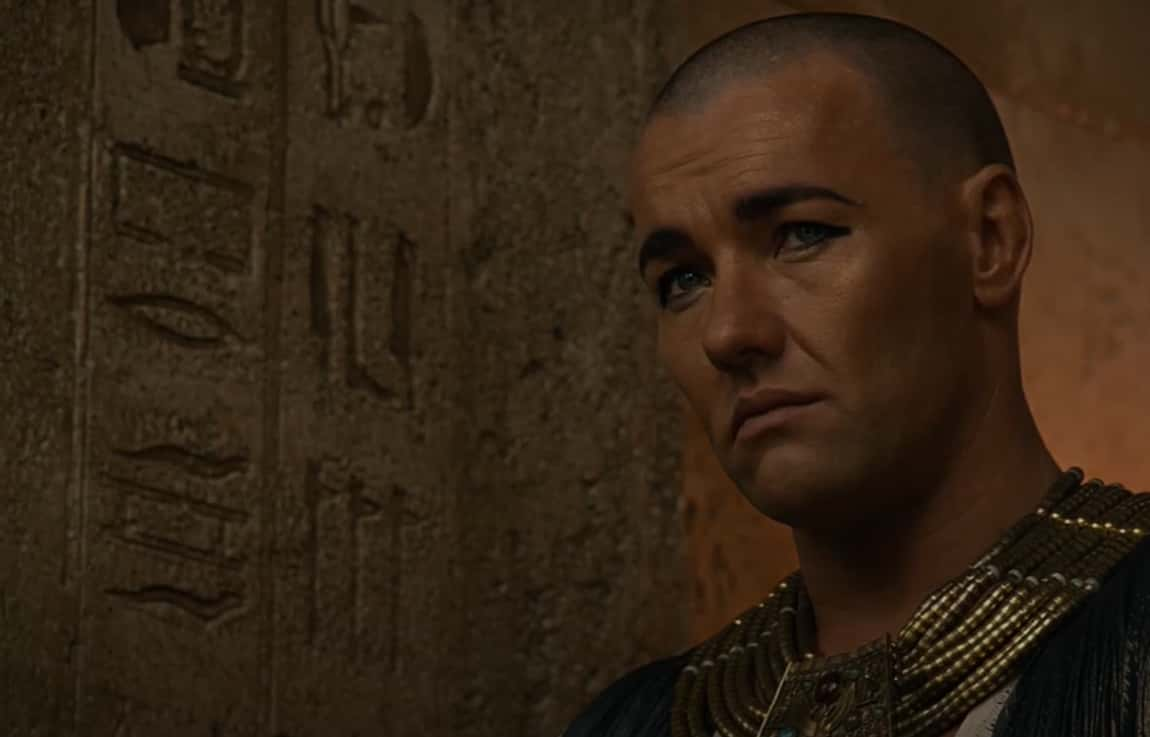 Exodus: Gods and Kings (2014), 20th Century Fox
Exodus: Gods and Kings (2014), 20th Century Fox
40. His Mummy Is Eerily Well-Preserved
Ramses desperately wanted to be remembered, so I'm sure he'd be pleased that his mummy ended up remarkably well preserved. By examining the remains, archaeologists have a very precise idea of what the man looked like in life. He had uncharacteristically fair skin and red hair. The god-king towered over many of his subjects at over six feet tall and boasted a noticeably hooked, aquiline nose.
Looking at Ramses's mummy today is rather disturbing. Despite the fact that he's been gone for millennia and should have turned to dust centuries ago, you can really see the man that he was when you look at his face.
41. He Went on a French Vacation
Before he finally laid to rest in Cairo's Egyptian Museum, Ramses had one final trip to take. Archaeologists shipped the remains to France, where they had better facilities. However, European countries have a long history of pilfering Egyptian artifacts and keeping them for themselves. This time, the Egyptian government wanted to be sure that they got their mummy back. So, they resorted to a bizarre plan.
42. He Even Brought His Passport
According to many reports, the Egyptian government actually issued the centuries-old Ramses II a passport for the trip to France. They even listed his occupation as "King (deceased)." It would be a lot harder for the French to keep the mummy if it was technically an Egyptian citizen.
43. His Mummy Tells a Painful Tale
Ramses's mummy doesn't just look uncanny—it provides an amazing look into the pharaoh's life. Every old battle wound, every broken bone, even the ravages of arthritis are plain to be seen.
44. He Moved Around a Lot
When archaeologists finally found Ramses the Great, thousands of years later, he was in a surprising location. Rather than ending up in a grand tomb befitting of a great pharaoh, Ramses ended up unceremoniously tossed in the tomb a high priest. So how did this self-important god-king end up in a stranger's tomb? Well, in Ramses's case, his "final" resting place didn't end up being so final...
45. Raiders Pillaged His Tomb
Ramses was originally laid to rest in an extravagant tomb of his own in the Valley of Kings, but it turns out, burying a king with piles and piles of treasure leads to some...complications. Looters pillaged tombs all across the Valley of Kings, and evidently they weren't afraid of Ramses's ghost coming back to haunt them. They ransacked Ramses's burial chamber, and panicked priests decided they needed to do something.
46. Priest Had to Hide Him
First, priests took Ramses's mummy and moved it to the tomb of Queen Ahmose Inhapy. Apparently, they weren't too happy with the spot they'd chosen, because they picked up the sarcophagus again just three days later and moved it to the high priest's tomb, where Ramses stayed for thousands of years.
That's a pretty detailed account of body-moving from 3,000 years ago, so how do we know so much about it? Well, the priests were kind enough to carve the story right into Ramses's coffin, so no one would be confused as to how this great king ended up in a humble tomb.
47. He Ended Up in a Simple Box
For all of the awesome monuments he left behind, Ramses ended up in a humble wooden coffin. When archaeologists uncovered the simple box, they had no clue one of Egypt's most important pharaohs lay inside.
48. He Lost His Wife Early
Ramses had one of the longest reigns of any pharaoh, but sadly, his beloved Nefertari wasn't there by his side til the end. Nefertari suddenly passed early in their marriage. Some historians believe her end was due to complications in childbirth, but it's impossible to know for sure. What we do know is that Nefertari was gone—and that Ramses was devastated.
 The Ten Commandments (1956), Paramount Pictures
The Ten Commandments (1956), Paramount Pictures
49. He Never Forgot About Her
Ramses had to move on after Nefertari left this world. He made another one of his wives his queen and carried on the business of ruling Egypt, but Nefertari never strayed far from his thoughts. Even decades after her loss, he still commissioned sculptures and engravings in her likeness. He professed his love for her all across Egypt—but no monument was greater than her final resting place, one of the most beautiful sites in the ancient world.
 The Ten Commandments (1956), Paramount Pictures
The Ten Commandments (1956), Paramount Pictures
50. His Wife's Tomb Was Achingly Beautiful
Unfortunately, looters ransacked nearly every ancient Egyptian tomb centuries before modern archaeologists ever discovered them. However, Nefertari's tomb was different. Though looters did indeed take all of the Queen's treasures, Ramses made sure that his beloved's tomb would still stand the test of time. Remarkable figures in vibrant colors cover nearly every surface, and many Egyptologists consider the tomb to be the pinnacle of Egyptian art.












